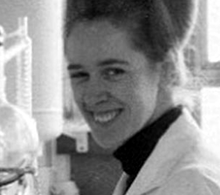Jean Purdy
| Jean Purdy | |
|---|---|
 | |
| Born |
Jean Marian Purdy April 25, 1945 Cambridge, England |
| Died | March 16, 1985 (aged 39) |
| Known for | in vitro fertilization |
| Scientific career | |
| Fields | |
Jean Marian Purdy was a British nurse and embryologist and a pioneer of fertility treatment. Purdy was responsible with biologist and physiologist Robert Edwards and obstetrician and gynaecologist Patrick Steptoe for developing in vitro fertilization. Louise Joy Brown, the first test-tube baby, was born on 25 July 1978,[1][2] and Purdy was the first to see the embryonic cells dividing.[3] Edwards was awarded the 2010 Nobel Prize in Physiology or Medicine for his work on the development of in vitro fertilization, however because the Nobel Prize is not awarded posthumously, neither Purdy nor Steptoe were eligible for consideration.[4] Purdy was a co-founder of the Bourn Hall Clinic but her role there and in the development of IVF was ignored for thirty years.
Education
Purdy attended the Cambridgeshire High School for Girls between 1956 and 1963 where she became a prefect, joined sports teams and played violin in the orchestra. She trained to be a nurse at Addenbrooke's Hospital in Cambridge.[5]
Career
After gaining registration as a nurse, Purdy moved to Southampton General Hospital, but was unhappy there and applied for a research post locally to work on tissue rejection, before transferring to Papworth Hospital in her home county where the first open-heart surgeries (and, later, heart transplants) were pioneered in Britain. In 1968, she applied for and attained a post with Robert Edwards at the Physiological Laboratory in Cambridge[6][5]
Work with Edwards and Steptoe
Steptoe became the Director of the Centre for Human Reproduction, Oldham in 1969. Using laparoscopy, he collected the ova from volunteering infertile women who saw his place as their last hope to achieve a pregnancy. Edwards and Purdy provided the laboratory expertise. It was Purdy who first saw that fertilised egg, which was to become Louise Brown, was dividing to make new cells.[7]
During this time they had to endure criticism and hostility to their work. Finally, in 1978, the birth of Louise Brown changed everything. To accommodate the increased patient number and train specialists, the team founded the Bourn Hall Clinic, Cambridgeshire in 1980 of which Steptoe was a Medical Director until his death.[7] Purdy was a co-author on 26 papers with Steptoe and Edwards,[3] and 370 IVF children were conceived during her career.[5]
Death
Purdy died in 1985 at the age of 39 from malignant melanoma.[5]
Recognition
When it was decided that a plaque should be put up to record the achievement Edwards suggested that the plaque should be phrased "Human in vitro fertilization followed by the world’s first successful pregnancy was performed at this hospital by Dr. Robert Edwards, Mr. Patrick Steptoe, Miss Jean Purdy and their supporting staff in November, 1977". Recognition for Purdy was ignored and the Oldham NHS Trust received a letter of complaint from Edwards in 1982. Bourn Hall erected a plaque in 2013 which again ignored Purdy's contribution.[6]
In a plenary lecture in 1998, celebrating the 20th anniversary of clinical IVF, Robert Edwards gave tribute to Jean Purdy, saying 'There were three original pioneers in IVF and not just two'.[5] Professor Andrew Steptoe, son of Patrick Steptoe unveiled a plaque in 2015 that acknowledged the three people who were involved in developing IVF.[8] In 2018, to mark the 40th anniversary of IVF, Bourn Hall unveiled a memorial to Jean Purdy, the "world's first IVF nurse and embryologist. Co-founder of Bourn Hall Clinic".[9]
References
- ↑ "1978: First 'test tube baby' born". BBC. 25 July 1978. Retrieved 2009-06-13.
The birth of the world's first "test tube baby" has been announced in Manchester (England). Louise Brown was born shortly before midnight in Oldham and District General Hospital
- ↑ Moreton, Cole (14 January 2007). "World's first test-tube baby Louise Brown has a child of her own". London: Independent. Retrieved 21 May 2010.
The 28-year-old, whose pioneering conception by in-vitro fertilisation made her famous around the world. The fertility specialists Patrick Steptoe and Bob Edwards became the first to successfully carry out IVF by extracting an egg, impregnating it with sperm and planting the resulting embryo back into the mother
- 1 2 Weule, Genelle (25 July 2018). "The first IVF baby was born 40 years ago today". ABC News. Retrieved 25 July 2018.
- ↑ "The 2010 Nobel Prize in Physiology or Medicine – Press Release". Nobelprize.org. 2010-10-04. Retrieved 2010-10-04.
- 1 2 3 4 5 Gosden, Roger (2017). ""Jean Marian Purdy remembered – the hidden life of an IVF pioneer"". Human Fertility. 21 (2): 86–69. doi:10.1080/14647273.2017.1351042.
- 1 2 Johnson, Martin H.; Elder, Kay (2015). ""The Oldham Notebooks: an analysis of the development of IVF 1969–1978. V. The role of Jean Purdy reassessed"". Reproductive Biomedicine & Society Online. 1 (1): 46–57. doi:10.1016/J.RBMS.2015.04.005.
- 1 2 Johnson, M. H.; Franklin, S. B.; Cottingham, M.; Hopwood, N. (2010). "Why the Medical Research Council refused Robert Edwards and Patrick Steptoe support for research on human conception in 1971". Human Reproduction. 25 (9): 2157–74. doi:10.1093/humrep/deq155. PMC 2922998. PMID 20657027.
- ↑ Kirby, Dean (2015-03-16). "Scientists who pioneered the first test-tube baby honoured with a blue plaque". men. Retrieved 2018-07-26.
- ↑ "ITV News". ITV Report. 20 July 2018. Retrieved 26 July 2018.